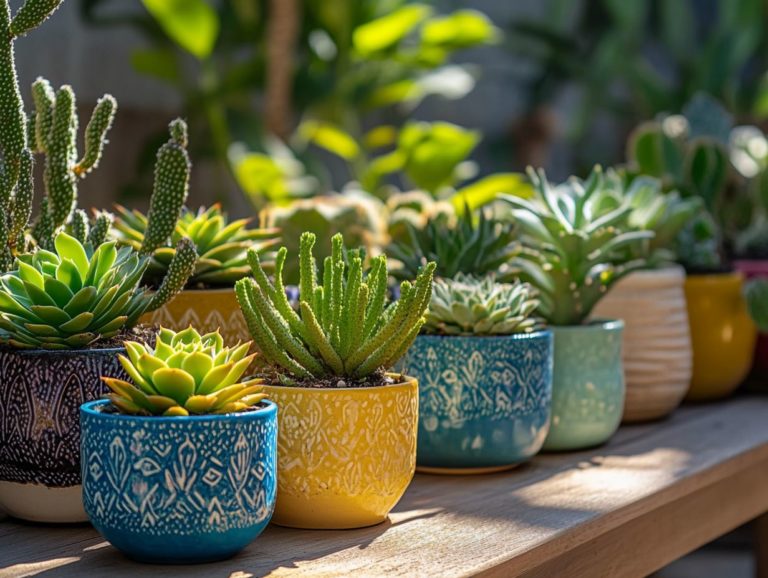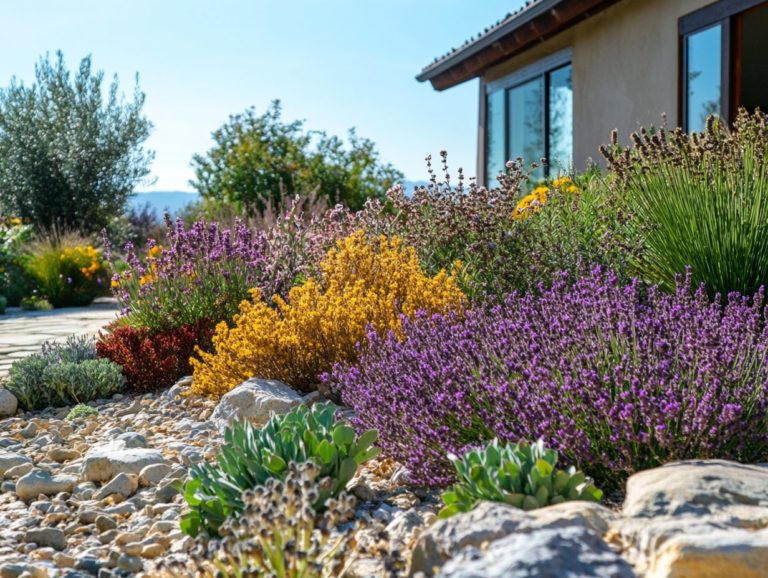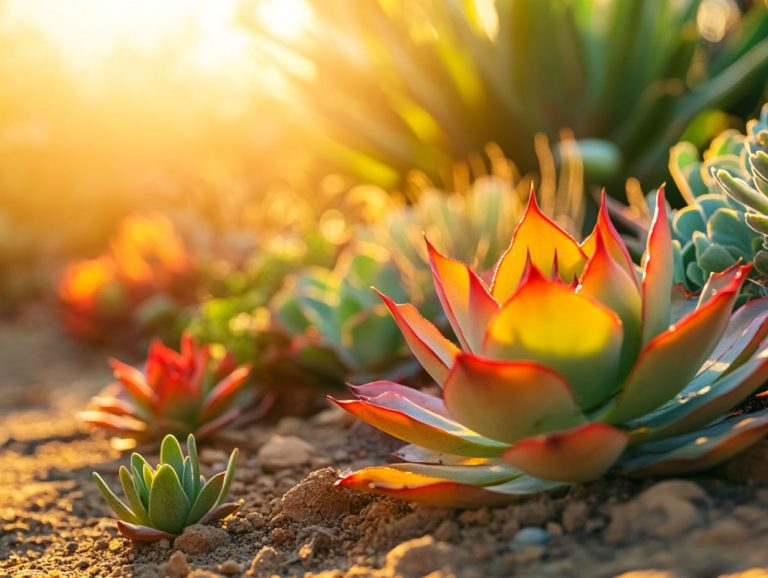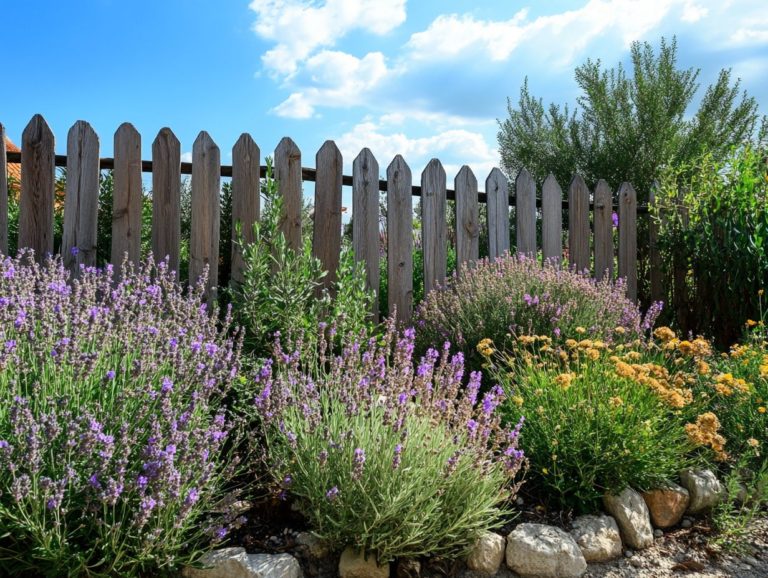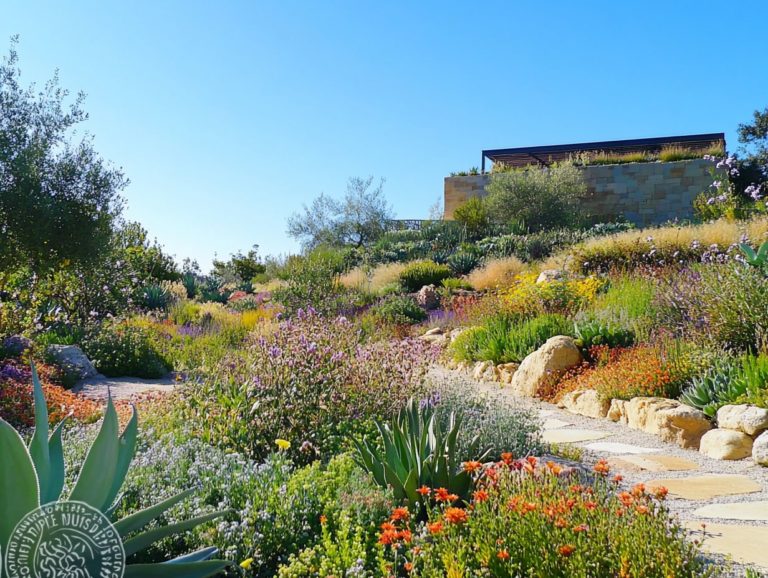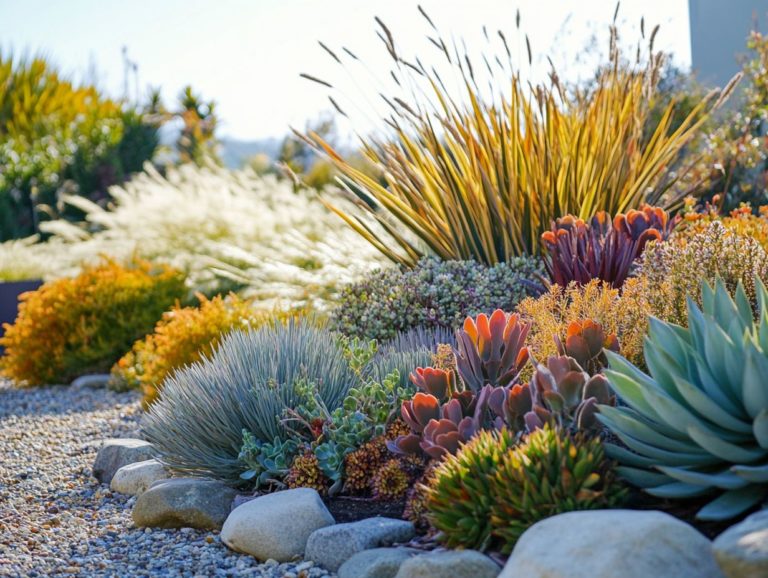Drought-Resistant Plants for Small Spaces
Tired of constantly watering your garden, only to see your plants wilt? Discover the beauty of plants that need little water, which provide a stunning solution, thriving even in the driest conditions.
This guide explores a variety of breathtaking options from succulents to bougainvillea that conserve water while enhancing your space. Learn how to care for these resilient plants, creatively display them in compact areas, and cultivate a sustainable garden that thrives on minimal water.
Transform your garden now and watch it thrive like never before!
Contents
- Key Takeaways:
- 1. Succulents
- 2. Lavender
- 3. Cacti
- 4. Rosemary
- 5. Agave
- 6. Yucca
- 7. Sage
- 8. Aloe Vera
- 9. Ornamental Grasses
- 10. Geraniums
- 11. Boxwood
- 12. Bougainvillea
- 13. Bamboo
- 14. Hens and Chicks
- 15. Drought-Tolerant Annuals
- What Makes These Plants Drought-Resistant?
- Frequently Asked Questions
- 1. What Are Drought-Resistant Plants and Why Are They Important for Small Spaces?
- 2. What Are Some Examples of Drought-Resistant Plants That Are Suitable for Small Spaces?
- 3. How Do I Care for Drought-Resistant Plants in Small Spaces?
- 4. Can Drought-Resistant Plants Be Grown in Containers in Small Spaces?
- 5. Are There Any Benefits to Using Drought-Resistant Plants in Small Spaces?
- 6. Can I Still Have a Variety of Plant Choices with Drought-Resistant Plants in Small Spaces?
Key Takeaways:
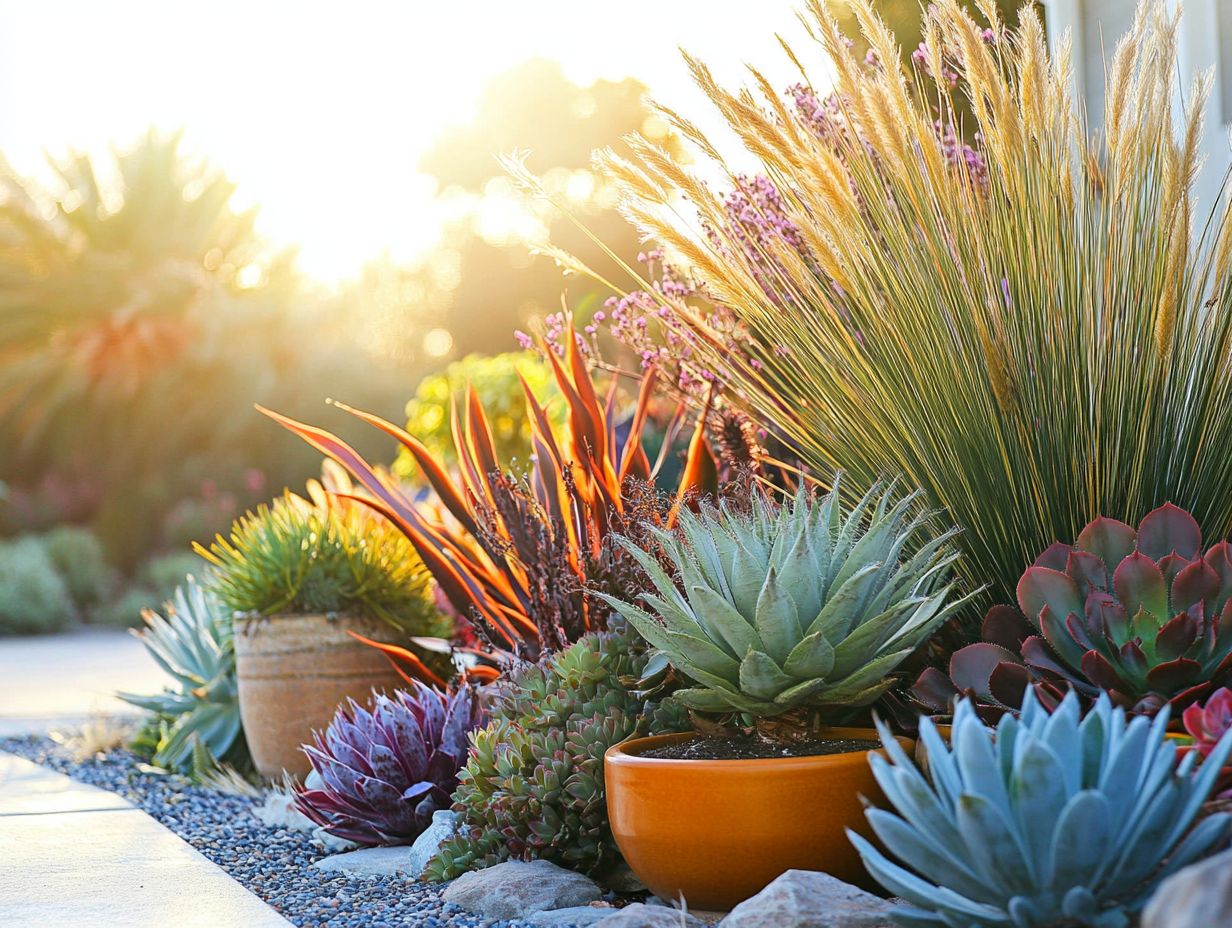
- Choose plants that need little water like succulents, lavender, and cacti for small spaces to conserve water and maintain an attractive garden.
- These plants require little care and thrive in limited water conditions, making them perfect for small spaces like balconies and windowsills.
- Incorporate these plants into your garden through creative displays and sustainable gardening practices to reduce water usage and promote a greener environment.
1. Succulents
Succulents stand out as the premier choice for landscaping that requires little water, needing minimal care while delivering stunning textures and forms that fit seamlessly into various designs.
Beyond their low water requirements, these resilient plants adapt impressively to a range of soil types, from sandy to clay, as long as drainage meaning the ability of soil to let water flow through is adequate. To create a visually captivating arrangement, pair succulents with other plants that need little water, such as native grasses or ornamental herbs, which beautifully complement their unique shapes and colors.
Pay attention to specific needs; for instance, varieties like Aster thrive in partial sun, while Hen and Chicks prefer full sun exposure, making thoughtful placement crucial. Regularly inspect for pests and ensure proper spacing to enhance airflow and overall health among your plants, resulting in a lush, sustainable garden that flourishes with minimal effort.
2. Lavender
Lavender is an excellent choice for your garden, loved for its drought-tolerant nature, aromatic foliage, and vibrant blooms. It not only elevates your landscape design but also draws in essential pollinators, enhancing the beauty and functionality of your outdoor space.
Various lavender species are adaptable, thriving in different climates, making them a versatile option for gardeners. For example, English lavender flourishes in cooler regions, while French lavender thrives in warmer, sunnier spots.
Each variety has its own care requirements, generally preferring well-drained soil and minimal watering once established, aligning perfectly with a low-maintenance garden ethos. Lavender adds color and fragrance and serves as a beautiful backdrop for companion plants like rosemary and thyme, creating a harmonious and inviting space that reflects the serene beauty of southern landscapes.
3. Cacti
Cacti are the ultimate plants that need little water, perfectly suited for environments where water is a luxury. They display unique shapes and vibrant colors while requiring minimal maintenance in your garden.
These resilient species not only elevate the aesthetic appeal of your landscape but also play a significant role in sustainable gardening practices. Popular varieties, such as the Saguaro and Barrel cactus, thrive in full sunlight and well-draining soil, making them ideal for rocky or sandy locales.
When you integrate these remarkable plants into your landscaping, group them based on their light and water requirements. Proper care includes ensuring the soil doesn’t retain moisture, as that can lead to root rot, which occurs when roots sit in water for too long. Understanding when they bloom during the summer can enhance your garden’s beauty, as many cacti flower in the hottest months.
Regularly check for pests and fine-tune your watering schedule throughout the growing season to keep them healthy and vibrant.
4. Rosemary
Rosemary is truly the star of plants that need little water. It often graces the Mediterranean landscape with its aromatic leaves and robust growth that demands minimal water. This makes it a superb choice for your outdoor gardening endeavors.
Its versatility goes beyond the kitchen, where it elevates dishes with a distinct flavor profile. It also transforms landscapes by adding visual interest and texture to your gardens. Imagine it working in perfect harmony with other drought-resistant beauties like lavender and thyme, creating a vibrant and resilient outdoor space.
These plants prefer well-draining soil, which guards against root rot and fosters healthy growth. Regular pruning is essential for a fuller appearance and to spark new growth. This ensures your rosemary maintains its lush and vigorous charm.
By avoiding waterlogged conditions and providing plenty of sunlight, you can cultivate a flourishing herb garden that s both beautiful and practical.
5. Agave
Discover the incredible allure of agave plants, known for their striking architectural forms and impressive drought tolerance. They thrive effortlessly in low-maintenance gardens and provide effective erosion control in challenging landscapes.
These succulent marvels, including species like Agave americana and Agave parryi, capture attention with their bold rosettes and unique textures. They serve as excellent choices for landscaping due to their minimal upkeep requirements.
They fulfill multiple roles from adding drama to water-efficient gardens to acting as a natural barrier against soil degradation. For optimal growth, plant them in well-draining soil, as they don’t fare well in waterlogged conditions.
Understanding their needs, such as a preference for full sun exposure and minimal moisture, helps you create resilient and beautiful outdoor spaces that enhance soil stability over time.
6. Yucca
Yucca plants are truly hardy and drought-tolerant gems. They are celebrated for their striking foliage and remarkable ability to thrive in low-maintenance outdoor gardening environments while conserving water efficiently.
Their sword-like leaves introduce a dramatic flair to any landscape. This makes them a favored choice for both modern and traditional designs. With various species at your disposal, yuccas offer an array of colors and forms that seamlessly complement other drought-resistant plants, like agave or sedum.
When strategically placed, yucca can create an arrangement that pleases the eye and balances texture and color throughout the seasons. Caring for these resilient beauties is minimal; they thrive in well-drained soil and only require occasional pruning to remove dead leaves.
This allows you to enjoy their aesthetic charm without the weight of extensive upkeep.
7. Sage
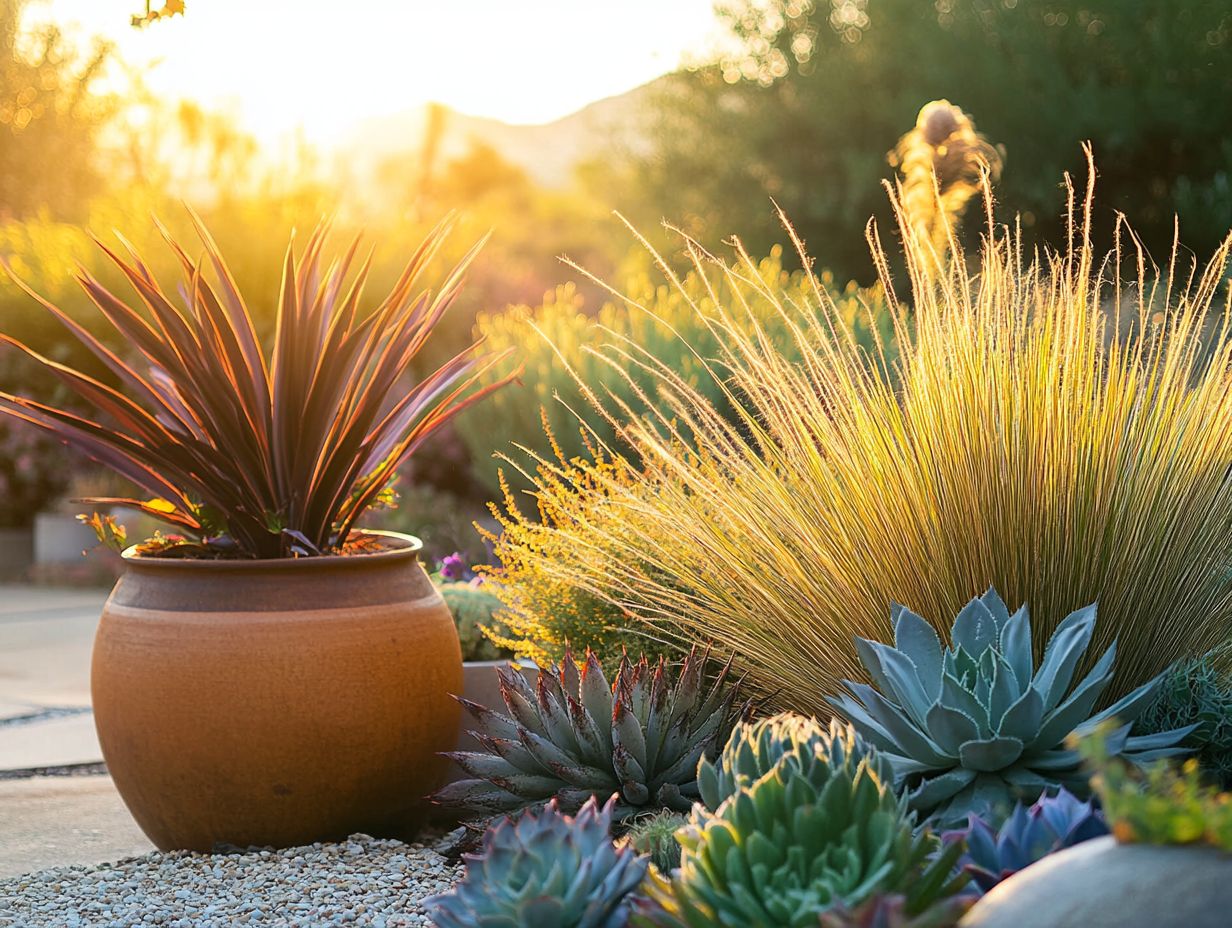
Discover the incredible versatility of sage your best ally for a stunning, water-efficient garden! This remarkable herb thrives with minimal care and attracts pollinators during its enchanting summer bloom.
You ll find sage in delightful varieties like common sage, pineapple sage, and purple sage. Each introduces its unique flavors and textures to your culinary masterpieces. In the kitchen, sage imparts a robust, earthy flavor that elevates dishes like roasted meats, stuffing, and pasta to a whole new level.
In terms of landscaping, sage makes a striking statement, especially when paired with other drought-resistant companions like lavender and rosemary. Together, they create a harmonious, low-water display that s sure to impress.
For optimal growth, sage prefers well-drained soil and full sun. This makes it an excellent choice for gardening without much water. Its relatively pest-resistant nature makes it a favorite among both novice and seasoned gardeners alike.
Ready to transform your garden with these resilient beauties? Start planting today!
8. Aloe Vera
Aloe Vera is a low-maintenance gem for outdoor gardening. It s revered for its medicinal properties and thrives in dry conditions.
This succulent is brimming with vitamins, minerals, and antioxidants, making it a go-to remedy for various skin issues and digestive troubles. Its gel offers soothing relief from minor burns and sunburns, proving to be an invaluable asset in any household.
Caring for Aloe Vera is a piece of cake; it demands minimal watering and adapts well to different soil types, making it a delight for gardeners at every skill level.
Integrating Aloe Vera into your drought-resistant landscaping is a breeze. It pairs effortlessly with other succulents, native plants, and even ornamental grasses, crafting a vibrant, low-water garden that enhances variety of plants and animals while conserving precious resources.
9. Ornamental Grasses
Ornamental grasses are exceptional plants that need less water and elevate your landscape design with their graceful forms and textures, all while promoting low-maintenance outdoor gardening. These waterwise plants are perfect for maintaining an eco-friendly garden.
Ornamental grasses fit various styles, from contemporary to rustic gardens. They create visual interest throughout the seasons. As they sway gently in the breeze, they not only bring movement to your space but also attract beneficial wildlife, infusing life and vibrancy into your garden.
To ensure these plants thrive over time, proper care is key; this includes regular trimming, vigilant pest monitoring, and strategic watering practices. By choosing native or adapted species, including groundcover types that conserve water, you can further enhance their resilience, making them perfectly suited for a variety of climates while contributing to local ecosystems.
10. Geraniums
Geraniums are a true delight, celebrated for their vibrant colors and remarkable resilience. They make an excellent choice for drought-tolerant gardens, thriving effortlessly in low-maintenance outdoor settings while charming pollinators along the way.
Zonal geraniums stand out with their rounded, variegated leaves and stunning clusters of flowers, perfect for enhancing borders and containers. Ivy geraniums showcase their trailing vines beautifully, ideal for hanging baskets or cascading gracefully over walls. If you seek fragrant options, scented geraniums add aromatic leaves to the table, creating a beautiful display of blooms.
All geraniums thrive in well-draining soil and bask in sunlight, requiring minimal watering once they’re established. During the summer bloom season, their vivid hues can truly transform any space, creating a lively backdrop for outdoor gatherings or a serene retreat in nature.
11. Boxwood
Boxwood is a top choice for drought-tolerant landscaping, celebrated for its versatility and low-maintenance nature, making it a cornerstone in outdoor gardening that effectively addresses climate change challenges.
With a variety of options available, including American, English, and Japanese boxwoods, you’ll find they seamlessly contribute to structured and elegant garden designs. These plants can serve as hedges, borders, or even topiary, bringing unique shapes that elevate visual interest in your landscape. Caring for boxwoods is quite manageable; a bit of regular trimming and ensuring they have adequate drainage will keep them thriving.
When you pair boxwoods with other drought-resistant plants like sedums or lavender, you create a stunning tapestry of textures and colors, adding remarkable depth to your landscape while ensuring your design meets high standards of quality.
12. Bougainvillea
Bougainvillea adds a vibrant splash of color to any landscape. It thrives in outdoor gardens and needs minimal maintenance, making it a great choice for drought-tolerant landscaping.
Its stunning bracts come in colors from deep magenta to sunny yellow. This versatile plant thrives in full sun and well-drained soil, even in dry conditions.
To elevate your landscape, incorporate bougainvillea as it creates striking focal points. It can climb walls, cascade from pots, or serve as a lovely hedge in mixed borders.
Its year-round blooms make it perfect for drought-resistant gardens that still crave beauty.
13. Bamboo
Bamboo is a captivating, drought-tolerant plant that enhances your garden’s beauty. It also helps with erosion control, maintaining soil health during water restrictions.
This grass has many species, each with unique growth patterns suited for different gardening. Varieties like Fargesia and Bambusa flourish in hot, dry climates with minimal irrigation.
These bamboo varieties improve soil health and encourage biodiversity. They highlight the ecological benefits of sustainable landscaping.
14. Hens and Chicks
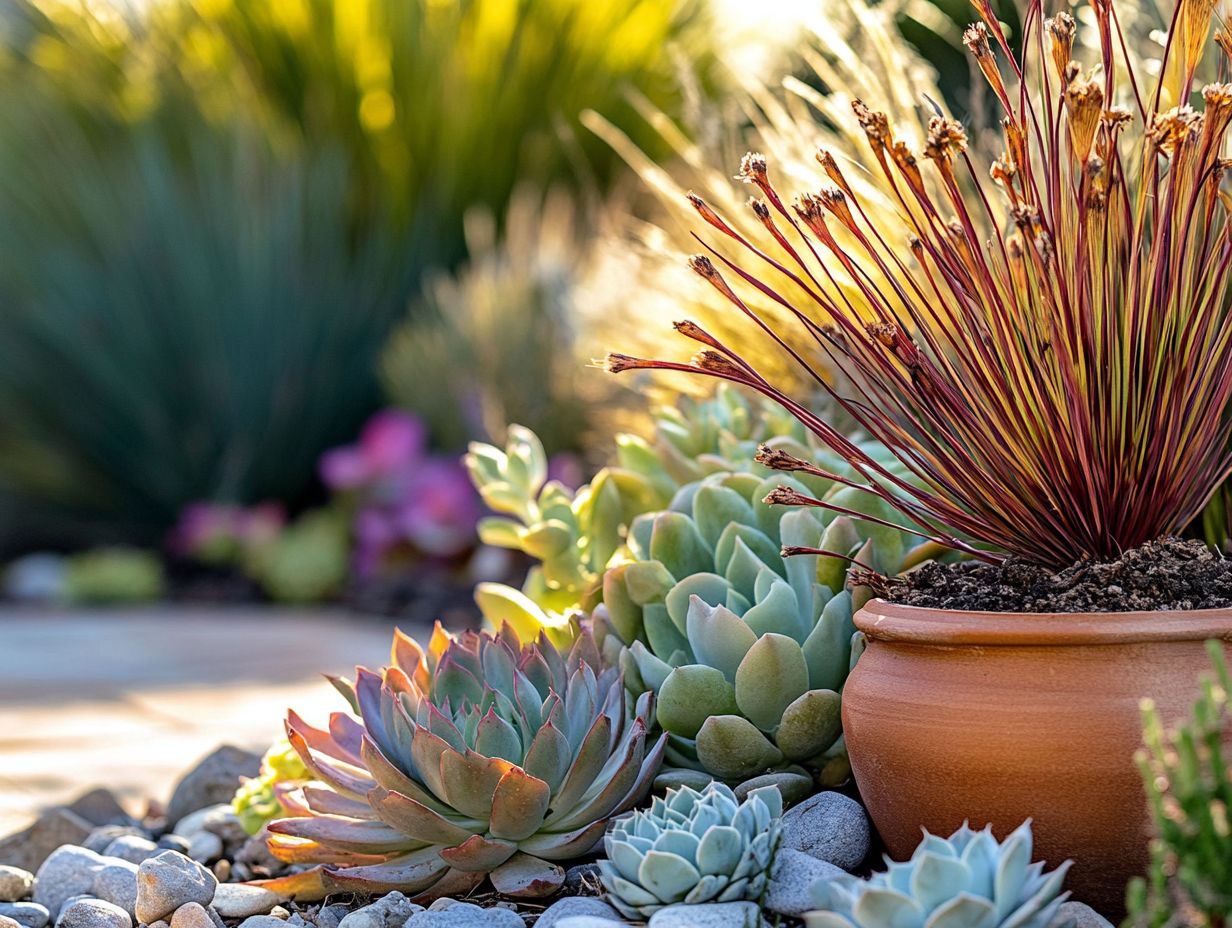
Hens and Chicks are charming, drought-tolerant plants that thrive in low-maintenance gardens. They form stunning rosettes that need minimal water and well-draining soil.
These resilient succulents adapt to various environments. Whether in a rock garden or a vibrant container, they add an eye-catching aesthetic to any landscape.
Propagation is easy; just detach the offsets or ‘chicks’ from the mother plant. This simplicity sparks creativity and helps these hardy plants spread throughout your garden while conserving water.
15. Drought-Tolerant Annuals
Drought-tolerant annuals offer a chance to enjoy vibrant blooms all summer. They conserve water and attract pollinators to your garden, making them ideal for sustainable gardening.
Plants like zinnias and cosmos bring stunning colors during hot months. They also create habitats for bees and butterflies, supporting ecological balance in your garden.
To care for these beauties, plant them in well-draining soil and ensure they get enough sunlight. Regularly deadheading spent blooms extends their flowering period, keeping your garden lively and inviting.
With a little attention, these annuals can transform your landscape into a vibrant sanctuary that thrives even in dry conditions.
What Makes These Plants Drought-Resistant?
Drought-resistant plants have remarkable adaptations that allow them to conserve water and thrive in arid environments. For a deeper understanding, check out the top 10 drought-resistant plants for water-saving gardens. They are invaluable allies in your quest for sustainable outdoor gardening and low-maintenance landscaping.
These adaptations include deep root systems that reach below ground to access hidden moisture layers, a crucial trait for drought-resistant plants. Many resilient species have specialized leaf structures, such as waxy coatings or reduced surface areas, which significantly minimize water loss through evaporation. This is especially important in the face of climate change.
Take succulents, for example. Aloe vera stores moisture in its fleshy leaves, while mesquite trees have long taproots that go deep into the soil, ensuring a steady water supply. Their features not only guarantee survival during dry spells but also enhance the ecological health of their surroundings.
How Can These Plants Be Used in Small Spaces?
Drought-tolerant plants can be creatively used in your small outdoor areas, transforming your gardening experience. Consider the best drought-resistant plants for containers, as they bring vibrant colors and textures that elevate your landscape design.
By selecting the right varieties, you can create a stunning garden that bursts with life while thriving on minimal water. Imagine turning even the tiniest balcony or patio into a lush retreat through vertical gardening, using walls, fences, or trellises to support climbing plants and create an inviting atmosphere.
Container gardening is a fantastic solution for adding immediate greenery. With pots, you can rearrange your plants based on sun exposure or your aesthetic preferences. When planning your layout, think about grouping plants with similar water needs and varying pot sizes to add depth and visual interest.
This strategy conserves water and guarantees an eye-catching display that will impress anyone who visits, creating a vibrant sanctuary for all to enjoy.
What Are the Best Ways to Care for Drought-Resistant Plants?
Caring for drought-resistant plants requires understanding their unique needs, which typically involve minimal watering and attention to soil conditions to promote healthy growth.
Best practices include crafting well-draining soil and using organic mulch, which helps retain moisture in the soil. These methods significantly enhance the resilience of these plants, ensuring they thrive even under water restrictions.
Water deeply and infrequently, encouraging roots to delve deeper in search of moisture. This approach reduces how often you need to irrigate.
Implement pest control measures tailored to these hardy varieties, like using insecticidal soap or introducing beneficial insects. This will safeguard them from potential threats while minimizing overall maintenance, allowing you to focus on creating a beautiful and sustainable landscape.
In the end, these strategies cultivate a flourishing garden and conserve your time and resources. Start today to transform your outdoor space into a water-saving oasis!
How Can These Plants Be Incorporated into a Sustainable Garden?
Incorporating low-maintenance drought-resistant plants into your sustainable garden design can dramatically reduce water usage while promoting biodiversity. This results in an environmentally friendly outdoor space.
This approach cuts down on the need for irrigation and encourages the use of native species that thrive in your local conditions, especially in the context of climate change.
By selecting plants that coexist harmoniously known as companion planting you can enhance pest control and improve nutrient cycling, further supporting a healthy ecosystem.
Employing effective water conservation methods, such as rainwater harvesting and mulching, allows you to use resources more efficiently. This ensures your garden remains vibrant even during dry spells. Integrating these strategies sets the stage for a flourishing landscape that respects and nurtures the environment.
What Are Some Creative Ways to Display Drought-Resistant Plants in Small Spaces?
Creative display techniques for drought-tolerant plants in small spaces can truly elevate your outdoor gardening areas into charming sanctuaries. Consider incorporating drought-resistant plants for a colorful garden, as these areas can be both functional and visually stunning, showcasing low-maintenance plants.
By incorporating innovative elements like vertical gardens and unique container arrangements, you can maximize those limited areas while showcasing the remarkable variety of drought-resistant plants available to you. Vertical installations not only save precious ground space but also introduce depth and texture, making your garden feel more inviting.
Thoughtfully arranged containers can transform into mini-gardens that draw the eye, especially when paired with colorful flowers and eye-catching decorations.
To further enhance visual appeal, consider integrating hard surfaces like paths and borders. These features instantly create structure and excitement in your garden! They provide distinct focal points, allowing your lush greenery to truly shine, even in smaller settings, while also helping with erosion control.
Frequently Asked Questions
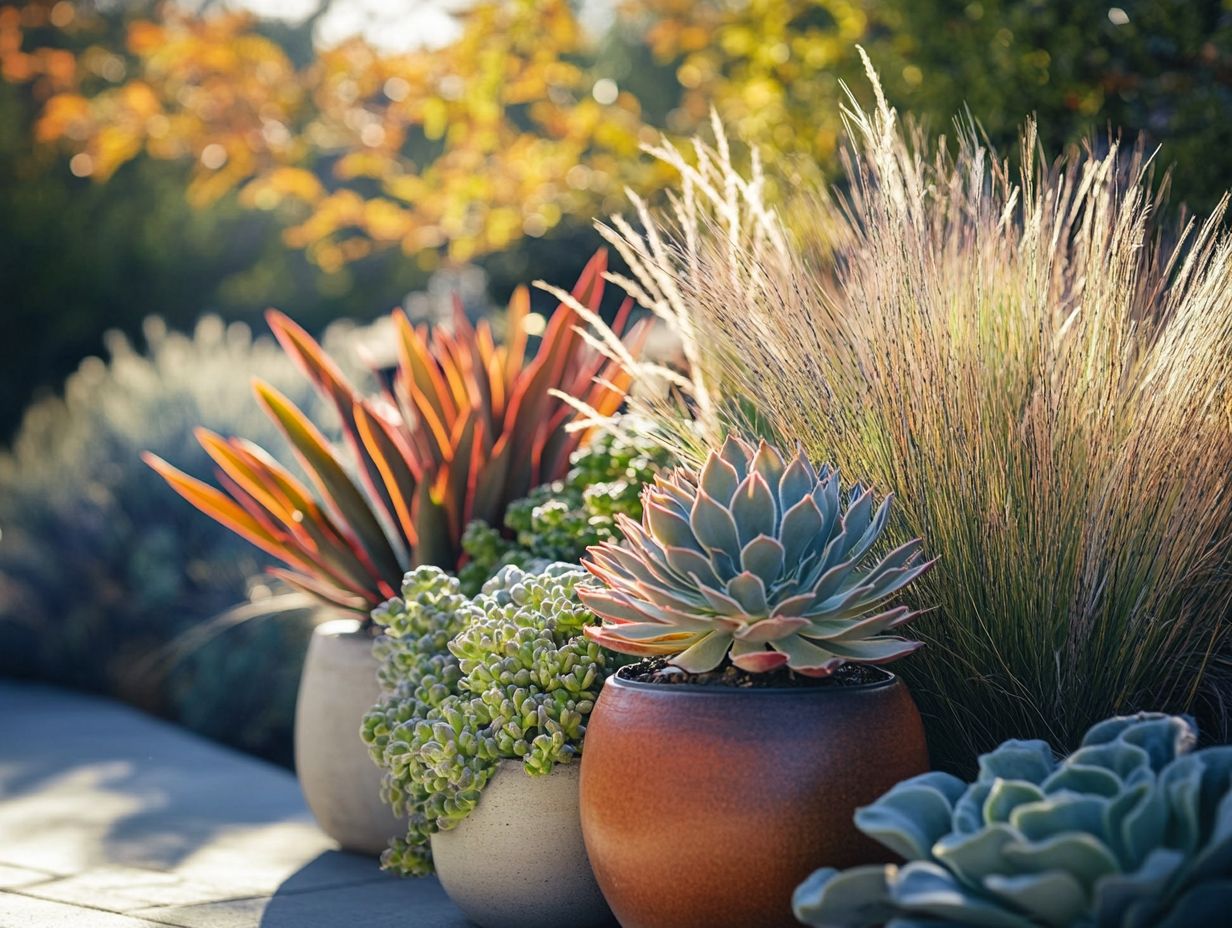
1. What Are Drought-Resistant Plants and Why Are They Important for Small Spaces?
Drought-resistant plants, including various groundcover types, are especially suited to survive in dry conditions. Incorporating drought-resistant shrubs for low-water gardens is essential for small spaces because they require less water and maintenance, making them ideal for areas with limited resources.
2. What Are Some Examples of Drought-Resistant Plants That Are Suitable for Small Spaces?
Examples of drought-resistant plants for small spaces include succulents, cacti, lavender, rosemary, and agave, as well as Aster and Black-eyed Susan. For innovative ideas on how to arrange these plants, check out small space landscaping for drought areas. These plants have thick leaves or stems that store water, allowing them to thrive even during dry periods.
3. How Do I Care for Drought-Resistant Plants in Small Spaces?
Drought-resistant plants still need some care, such as regular watering and occasional pruning. However, they require less water and can thrive in well-draining soil, making them suitable for regions like the Mediterranean. It’s crucial to research the specific needs of each plant for optimal care.
4. Can Drought-Resistant Plants Be Grown in Containers in Small Spaces?
Yes, many drought-resistant plants can be grown in containers, offering versatility in design and placement. To ensure you select the right options, it’s helpful to learn how to choose drought-resistant plants. This makes it easier to control how much water each plant receives.
5. Are There Any Benefits to Using Drought-Resistant Plants in Small Spaces?
Aside from requiring less water and maintenance, drought-resistant plants also add color and texture to your garden. They attract pollinators and can even improve air quality, making them invaluable in landscape design.
6. Can I Still Have a Variety of Plant Choices with Drought-Resistant Plants in Small Spaces?
Yes, there is a wide variety of drought-resistant plants available for small spaces, including drought-tolerant groundcovers and summer-blooming plants. From colorful flowering plants to unique drought-resistant plants for your home, there are plenty of options to choose from that can add interest and beauty to your space.
Ready to transform your small space? Start your drought-resistant garden today!

